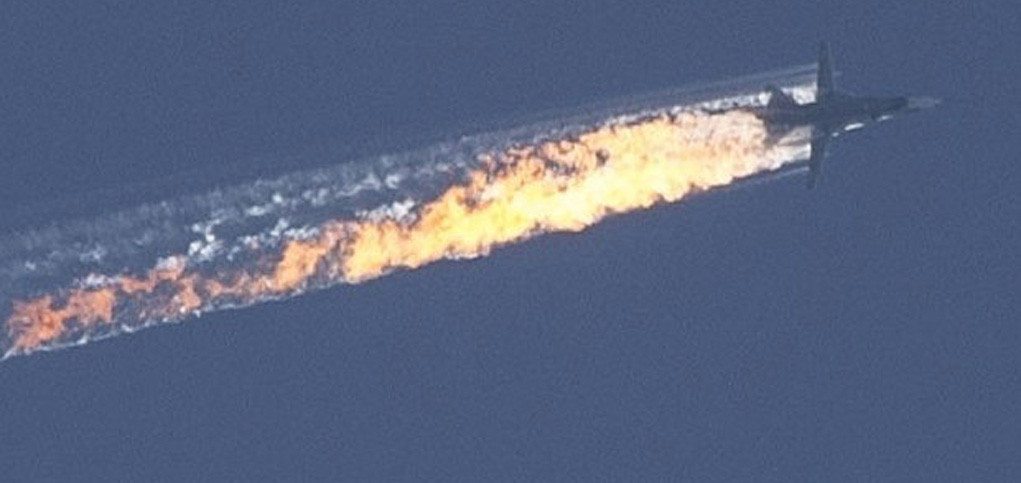A Russian Air Force (RuAF) Sukhoi Su-24M attack jet was shot down by Turkish Air Force (TuAF) F-16C fighter jets over the Syrian-Turkish border on the morning of Tuesday, 24 November 2015. This article takes a look at what went down (pun intended), and how such an incident might further complicate the state of affairs in Syria. Before that, let us examine the two aircraft involved in the shoot-down.
The Su-24M is a modern variant of the initial production Sukhoi Su-24 Fencer – a supersonic, twin-engine, twin-seat, all-weather attack jet (also known as a ‘tactical bomber’) featuring variable-geometry wings (like the General Dynamics F-111 Aardvark). The Su-24M has a slightly longer nose cone with a single probe in place of the three-part probe found on the previous variants. Its variable-geometry wings have a total of four sweep settings: 16 degrees at the foremost position for Short Take-Off and Landing (STOL), 35 and 45 degrees middle positions for cruising, and 69 degrees at the rearmost position for high-speed flight. The Fencer-D, as the Su-24M is also referred to, features a retractable refueling probe for mid-air refuel capability, chaff and flare dispensers, a PNS-24M inertial navigation system, a redesigned compartment housing the attack radar, a Kaira-24 laser/optical targeting pod (on the left side of the fuselage), as well as a Tekon search and track system for precision-guided munitions. The attack jet has a maximum speed of Mach 1.05 at sea level, or Mach 1.35 at high altitude. It has a wing loading of 651 kilograms per square metre, and a maximum G-loading of 6.0 Gs. This design makes the Fencer optimally suited for performing precision strikes at low altitude, similar to the United States Air Force’s F-111 at the time.
The F-16C is the most dominant single-seat variant of the General Dynamics (now Lockheed Martin) F-16 Fighting Falcon – a supersonic, single-engine fighter jet with 40-degree fixed-geometry cropped-delta wings. The F-16C shares the same configuration as the initial production model – the F-16A single-seat fighter, but features an improved powerplant, upgraded avionics equipment and all-weather radar for beyond-visual-range (BVR) air-to-air missiles like the AIM-7 or the AIM-120. The F-16C Block 30, in use with the TuAF, is differentiated from the other production Blocks by its General Electric F110-GE-100 afterburning turbofan engine. The F-16C has a frame-less bubble canopy that affords the pilot excellent field-of-view for higher situational awareness, along with an elevated, 30-degree reclined pilot seat that reduces the adverse effects of high G-forces during sustained turns. The fighter also features a distinctive blended body, leading-edge root extensions (LERX, also known as wing strakes) for better control at low airspeeds. It has a maximum speed of Mach 1.2 at sea level, or Mach 2.0 at high altitude. The single-seat F-16C has a wing loading of 431 kilograms per square metre, with a maximum G-loading of 9.0 Gs. These features lend themselves well to the Falcon’s ability to engage fighters in within-visual-range (WVR) air combat, such as a sustained turn dogfight, as well as BVR interceptions.
The Su-24M in question, was one of two Russian Air Force Fencers flying strike operations in retaliation against Islamic State (otherwise called “Daesh”) militant groups, as well as the anti-Assad forces around the Syrian Kepir, Mortlu and Zahir settlements on the morning of 24 November.
Chief of Russian Air Force, Commander Viktor Bondarev, revealed details of what happened in the incident. According to him, the pair of Su-24Ms took off from Khmemim airbase at 6:15 GMT, each armed with four OFAB-250 high-explosive fragmentation bombs. The Fencers entered Turkish radar range ten minutes after take-off, and patrolled the target area at predetermined altitudes of 5,800m and 5,650m. There was no contact between the Russian attack pilots and Turkish fighter pilots or military authorities throughout the operation. The Su-24Ms executed two consecutive attack runs upon receiving target co-ordinates some 20 minutes after arriving on station. It was after conducting the second air-strike, that the Fencer flown by Lieutenant Colonel Oleg A. Peshkov and navigator Captain Konstantin V. Murakhtin took a direct hit from what was supposedly a close-range air-to-air missile. Commander Bondarev stated that the Turkish Air Force F-16C element operating out of Diyarbakır airfield were in the vicinity for around an hour before the shoot-down. One of the F-16C fighters allegedly broke its maneuvers and closed in on the Russian attack jet 100 seconds before the Su-24M neared the Turkish border. Bondarev revealed that the Turkish fighter had to penetrate Syrian airspace in order to engage the attack jet within a range of 5-7km. After entering Syrian airspace for 20 minutes, the F-16C made a steep dive towards the Turkish border, disappearing from Russian ground radars at Khmemim airbase. Commander Bondarev stressed that the Russian aircraft at no stage violated Turkish airspace. The Chief of Russian Air Force doubted Turkish authorities’ statement that they did not know the nationality of the aircraft operating in the area.
According to the statement released by Turkey, two aircraft of unidentified nationality violated Turkish airspace at the southern tip of Hatay province up to 2.19km deep for a duration of 17 seconds. Turkish Air Force reportedly gave the Su-24Ms a total of 10 warnings in the span of five minutes: “This is Turkish Air Force speaking en garde. You are approaching Turkish airspace. Change your heading south immediately,” which was supposedly repeated every 30 seconds prior to the alleged airspace violation. It is said one of the Fencers broke formation and egressed from Turkish airspace, leaving the other Su-24M on its continued westward heading. Said Su-24M was engaged by an element of TuAF F-16Cs on combat patrol in the vicinity. The aircraft was struck by an air-to-air missile fired by one of the F-16Cs at 9:24am local time, and subsequently crashed in Syrian territory about 1km from the Turkish border.
The pilot Lieutenant Colonel Peshkov and navigator Captain Murakhtin, successfully managed to eject from the Su-24M after it was hit at an altitude of 6,000m, before the burning aircraft plunged into the ground. As the two pilots descended via parachute, they were fired upon by Turkish militants allied with Syrian anti-government forces. Oleg A. Peshkov was reportedly killed by small arms fire from the Turkmen, later confirmed by the Russian Ministry of Defense. Lieutenant Colonel Peshkov was posthumously awarded the highest Russian honourary title – Hero of the Russian Federation. Navigator Konstantin Murakhtin was the sole survivor, and was later rescued by Russian and Syrian special operations forces, who tracked down his distress radio beacon and secured his release from the militants.
The Combat Search-and-Rescue (CSAR) operation was mounted by Russian special forces, as well as a team of eight Hezbolla and 18 Syrian commandos. Five Mi-8 Hip helicopters were used for the CSAR operation, one of which came under intense ground fire from militants while flying at low altitude near the downed Su-24M, and was forced to make an emergency landing. One Russian naval infantryman was killed in the ensuing firefight, while the rest of the crew were picked up shortly after. An online video posted by the Free Syrian Army’s 1st Coastal Division showed the stricken Mi-8, apparently abandoned and its rotors at standstill, being blown up by a BGM-71 Tube-launched, Optically-tracked, Wire-guided (TOW) anti-tank missile. It is said that the TOW anti-tank missile system was supplied by the U.S. military.
Captain Murakhtin testified that their aircraft never penetrated Turkish airspace, when he was interviewed by Russian media while recuperating at a Russian airbase near Latakia on Wednesday.
“We were flying at an altitude of 6,000 meters in completely clear weather, and I had total control of our flight path throughout,” the navigator said.
Murakhtin stated: “It’s impossible that we violated their airspace even for a second”.
He went on to explain that “In actual fact, there were no warnings at all. Neither through the radio, nor visually, so we did not at any point adjust our course. You need to understand the difference in speed between a tactical bomber like a Su-24, and that of the F-16. If they wanted to warn us, they could have sat on our wing” and that “As it was, the missile hit the back of our plane out of nowhere. We didn’t even have time to make an evasive maneuver”.
The account directly contradicted with that of the official Turkish statement released to the United Nations Security Council (UNSC).
However, an anonymous U.S. military official said that the Russian pilots “crossed into Turkish airspace”, after he was briefed on U.S. radar tracking data of the Su-24M.
Captain Murakhtin’s testimony was backed up by the Russian Ministry of Defense, countering Turkey’s and America’s statements. The Ministry stated that the Su-24M “remained exclusively above Syrian territory” with a map showing the continuous flight-path of the attack jet before it was downed. The Russian Defense Ministry cut all military contact with Turkey since the shoot-down.
Russian President Vladimir Putin called Turkey’s act “a stab in the back by the accomplices of terrorism”.
Russian Defense Minister Sergei K. Shoigu stated that Russia will bolster air defenses with batteries of S-400 Triumf mobile surface-to-air missile (SAM) system deployed to Latakia, Syria. The advanced S-400 SAM system is capable of tracking 300 aerial targets and engage 36 of them simultaneously, at an altitude of 185km, out to a range of over 400km. It utilises three different types of surface-to-air missiles to engage targets at different ranges; the 40N6 ultra-long range active radar-guided missile reaching out to 400+km, 48N6 long range semi-active radar-guided missile out to 250km, and the 9M96E2 medium range active radar-guided missile out to 120km. To further reinforce the area, the Russian Navy will move the guided missile cruiser Moskva to the shore zone of Latakia. The Moskva is armed with the S-300 Fort missile defense system, capable of engaging six targets out to over 152km away.
Once this happens, it will be difficult for aircraft other than U.S. Air Force F-22 stealth fighters and B-2 stealth bombers to operate effectively in the airspace around the Turkish-Syrian border.
Russia and Turkey have said that they do not intend to escalate this matter over boiling point, but as for whether either side will keep diplomatic channels open and resolve this peacefully remains to be seen.











